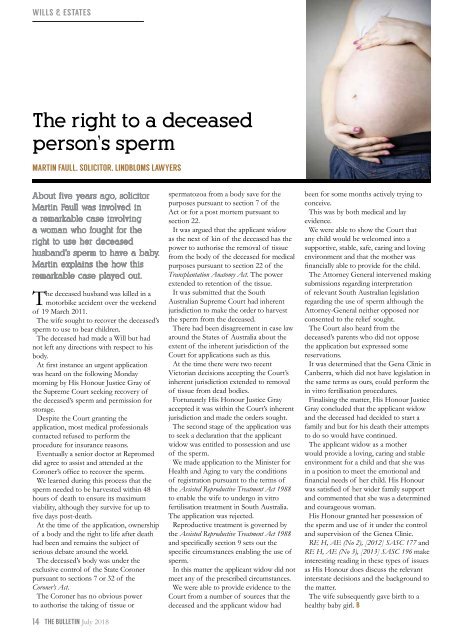LSB July 2018_Web
Create successful ePaper yourself
Turn your PDF publications into a flip-book with our unique Google optimized e-Paper software.
WILLS & ESTATES<br />
The right to a deceased<br />
person’s sperm<br />
MARTIN FAULL, SOLICITOR, LINDBLOMS LAWYERS<br />
About five years ago, solicitor<br />
Martin Faull was involved in<br />
a remarkable case involving<br />
a woman who fought for the<br />
right to use her deceased<br />
husband’s sperm to have a baby.<br />
Martin explains the how this<br />
remarkable case played out.<br />
The deceased husband was killed in a<br />
motorbike accident over the weekend<br />
of 19 March 2011.<br />
The wife sought to recover the deceased’s<br />
sperm to use to bear children.<br />
The deceased had made a Will but had<br />
not left any directions with respect to his<br />
body.<br />
At first instance an urgent application<br />
was heard on the following Monday<br />
morning by His Honour Justice Gray of<br />
the Supreme Court seeking recovery of<br />
the deceased’s sperm and permission for<br />
storage.<br />
Despite the Court granting the<br />
application, most medical professionals<br />
contacted refused to perform the<br />
procedure for insurance reasons.<br />
Eventually a senior doctor at Repromed<br />
did agree to assist and attended at the<br />
Coroner’s office to recover the sperm.<br />
We learned during this process that the<br />
sperm needed to be harvested within 48<br />
hours of death to ensure its maximum<br />
viability, although they survive for up to<br />
five days post-death.<br />
At the time of the application, ownership<br />
of a body and the right to life after death<br />
had been and remains the subject of<br />
serious debate around the world.<br />
The deceased’s body was under the<br />
exclusive control of the State Coroner<br />
pursuant to sections 7 or 32 of the<br />
Coroner’s Act.<br />
The Coroner has no obvious power<br />
to authorise the taking of tissue or<br />
spermatozoa from a body save for the<br />
purposes pursuant to section 7 of the<br />
Act or for a post mortem pursuant to<br />
section 22.<br />
It was argued that the applicant widow<br />
as the next of kin of the deceased has the<br />
power to authorise the removal of tissue<br />
from the body of the deceased for medical<br />
purposes pursuant to section 22 of the<br />
Transplantation Anatomy Act. The power<br />
extended to retention of the tissue.<br />
It was submitted that the South<br />
Australian Supreme Court had inherent<br />
jurisdiction to make the order to harvest<br />
the sperm from the deceased.<br />
There had been disagreement in case law<br />
around the States of Australia about the<br />
extent of the inherent jurisdiction of the<br />
Court for applications such as this.<br />
At the time there were two recent<br />
Victorian decisions accepting the Court’s<br />
inherent jurisdiction extended to removal<br />
of tissue from dead bodies.<br />
Fortunately His Honour Justice Gray<br />
accepted it was within the Court’s inherent<br />
jurisdiction and made the orders sought.<br />
The second stage of the application was<br />
to seek a declaration that the applicant<br />
widow was entitled to possession and use<br />
of the sperm.<br />
We made application to the Minister for<br />
Health and Aging to vary the conditions<br />
of registration pursuant to the terms of<br />
the Assisted Reproductive Treatment Act 1988<br />
to enable the wife to undergo in vitro<br />
fertilisation treatment in South Australia.<br />
The application was rejected.<br />
Reproductive treatment is governed by<br />
the Assisted Reproductive Treatment Act 1988<br />
and specifically section 9 sets out the<br />
specific circumstances enabling the use of<br />
sperm.<br />
In this matter the applicant widow did not<br />
meet any of the prescribed circumstances.<br />
We were able to provide evidence to the<br />
Court from a number of sources that the<br />
deceased and the applicant widow had<br />
been for some months actively trying to<br />
conceive.<br />
This was by both medical and lay<br />
evidence.<br />
We were able to show the Court that<br />
any child would be welcomed into a<br />
supportive, stable, safe, caring and loving<br />
environment and that the mother was<br />
financially able to provide for the child.<br />
The Attorney General intervened making<br />
submissions regarding interpretation<br />
of relevant South Australian legislation<br />
regarding the use of sperm although the<br />
Attorney-General neither opposed nor<br />
consented to the relief sought.<br />
The Court also heard from the<br />
deceased’s parents who did not oppose<br />
the application but expressed some<br />
reservations.<br />
It was determined that the Gena Clinic in<br />
Canberra, which did not have legislation in<br />
the same terms as ours, could perform the<br />
in vitro fertilisation procedures.<br />
Finalising the matter, His Honour Justice<br />
Gray concluded that the applicant widow<br />
and the deceased had decided to start a<br />
family and but for his death their attempts<br />
to do so would have continued.<br />
The applicant widow as a mother<br />
would provide a loving, caring and stable<br />
environment for a child and that she was<br />
in a position to meet the emotional and<br />
financial needs of her child. His Honour<br />
was satisfied of her wider family support<br />
and commented that she was a determined<br />
and courageous woman.<br />
His Honour granted her possession of<br />
the sperm and use of it under the control<br />
and supervision of the Genea Clinic.<br />
RE H, AE (No 2), [2012] SASC 177 and<br />
RE H, AE (No 3), [2013] SASC 196 make<br />
interesting reading in these types of issues<br />
as His Honour does discuss the relevant<br />
interstate decisions and the background to<br />
the matter.<br />
The wife subsequently gave birth to a<br />
healthy baby girl. B<br />
14<br />
THE BULLETIN <strong>July</strong> <strong>2018</strong>


















